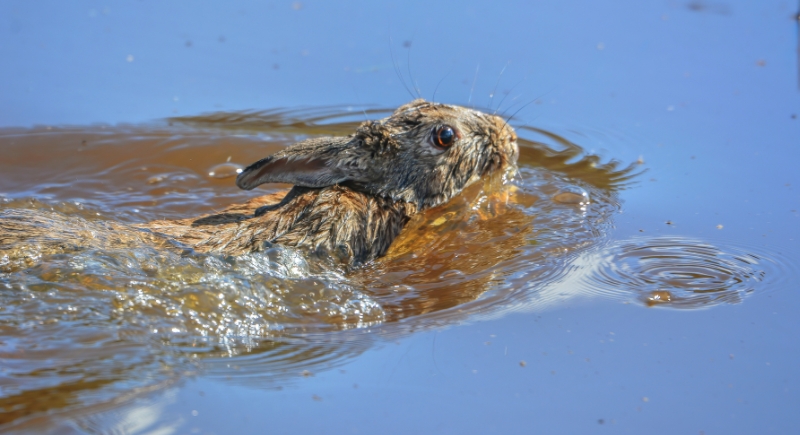A Veterinarian Explains the Risks of Letting Your Rabbit Near Water
Rabbits and water may seem harmless enough to you at first glance. You may have seen online clips that often show bunnies paddling in bathtubs or small pools, which makes it easy to believe they enjoy it. But veterinarians see a very different picture.
Domestic rabbits are built for dry ground and safety, not aquatic adventure. Even though wild species sometimes swim in emergencies, that doesn’t translate to pet care. Water exposure for a rabbit can mean unpleasant circumstances. However, understanding why these risks exist helps owners protect their pets.
Wild Rabbits and Swimming Adaptations

Image via iStockphoto/tracielouise
In the wild, only a few rabbit species evolved near wetlands where swimming helps survival. Swamp rabbits in the southeastern United States spend their lives near marshes and rivers, so paddling through water is both necessary and normal for them. Their bodies can handle it thanks to generations of adaptation that built greater endurance around water.
On the other hand, house rabbits lack that conditioning. They descend mostly from European stock that thrived in dry burrows and meadows. Without that background, they face fear and physical risk in water settings. Even cottontails, which occasionally cross shallow streams, do so under threat, not as a pastime.
The difference between necessity and choice matters. Pet rabbits should not be placed in water because they don’t have the reflexes or training to manage it. Specialists consistently point out this distinction to discourage owners who think wild behavior equals domestic suitability.
Stress Responses in Pet Rabbits
Domestic rabbits react strongly to new or threatening experiences. Contact with water can overwhelm them immediately. Their prey instincts trigger panic, which shows as frantic paddling or complete stillness. Both signs indicate extreme shock, which can push a rabbit into shock, which is a medical emergency that requires rapid intervention.
Even short encounters with water may create long-lasting anxiety that changes eating patterns or social behavior. On that note, experts warn that pet parents often misread body language during these events. A rabbit that appears calm may actually be freezing in fear. Flattened ears, stiff posture, and shallow breathing all point to distress. Stress also lowers immune function and leaves the animal more prone to illness after the incident.
For these reasons, professionals say water activities do not enrich a rabbit’s life. Instead, they increase risk without providing any benefit. Owners who want to see their pets active should focus on land-based play instead.
The Physical Dangers of Wet Fur

Image via iStockphoto/doug4537
Another major risk factor to keep in mind is that rabbit fur traps water easily and dries very slowly. Once soaked, it loses its insulating qualities, which puts the animal at risk of hypothermia even in mild conditions. A rabbit’s body temperature can drop quickly because it has few ways to regulate heat loss when wet. Respiratory infections may follow if the chill persists.
Wet fur also weighs down a rabbit and makes movement harder. It also increases fatigue during any attempt to swim. Unlike aquatic mammals, rabbits have no protective oils in their coat to repel water. Veterinarians frequently treat rabbits for complications linked to improper bathing or accidental water exposure. They recommend drying and warming immediately if an accident occurs, then calling a vet.